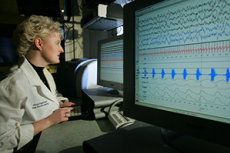
Recent research in the United States has found that it may in fact be possible to treat people's fears, while they are asleep. Common therapy for phobias already relies on ' gradual exposure' to their stressors, but it seems that it may be feasible to extend this therapy within slow-wave sleep, thus causing less anxiety for the participants, whilst improving their tolerance to their phobia. Scientists believe this is because slow-wave sleep is the deepest sleep cycle we enter, wherein memories, in particular those associated with emotions are supposedly processed.
In the experiment, 15 healthy participants were shown images of two differing faces. Whilst this was going on, they were all given a mild electric, along with inhaling a specific scent, such as lemon or mint. The shocks were used as a form of classical conditioning; they caused discomfort at the same time as the scents were detected, thereby causing the participants to subconsciously associate the scent as a negative thing due to the shocks.
Subsequently, participants were taken to sleep labs. As they entered the slow-wave cycle, they were once again exposed to the scent that they associated with one of the faces. When they awoke, they were once again shown the faces, but without scents or equally, any shocks. Less fear was displayed when participants were shown the face associated with the smell that they had been exposed to in their sleep, in comparison with the other face. fMRI (functional magnetic resonance imaging) scans were used to provide detail about activity in areas of the brain, along with the amount of sweat on the skin, an indicator of fear being measured.
Both the Hippocampus and the Amygdala showed noticeable changes; this could be potentially revolutionary as, in particular, the localised areas that play major roles in emotion and memory demonstrated a significant amount of activity. Although the decrease in fear was not especially large, scientists still respect this as an important breakthrough as it could potentially be used even beyond the treatment of phobias, but also for more severe distress caused by Post Traumatic Stress Disorder (PTSD).
Although in the grand scheme of things, this was a relatively small scale piece of research, and also conducted within a small time period, its value should not be underestimated. The test of whether we have indeed finally made some much needed headway in our battle against severe stress disorders will only be shown if such findings can be demonstrated on a larger scale over weeks and months. But for now, this research may be providing some much needed hope for those who thought that there would never be any way of living their lived than in fear.
Image: http://alaskaregional.com/service/sleep-lab

0 Comment:
Be the first one to comment on this article.